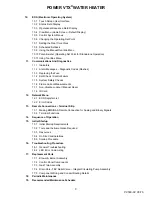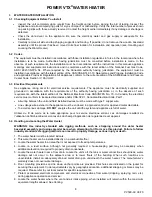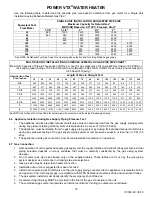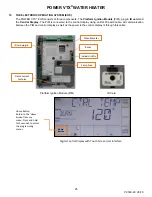
POWER VTX
®
WATER HEATER
16
PV500-68 06/16
7
COMBUSTION AND VENTILATION AIR
Provisions for adequate combustion and ventilation air to the mechanical room must be in accordance with Section
“Air for Combustion and Ventilation” in the latest edition of the NFPA 54 National Fuel Gas Code, ANSI Z223.1
and/or CAN/CSA B149, Installation Codes or applicable provisions of the local building codes. Any method
addressed in NFPA 54 National Fuel Gas Code section “Air for Combustion and Ventilation is acceptable and
several are outlined below.
7.1 Equipment Located In Confined Spaces
Equipment located in confined spaces requires two openings, one commencing within 12” (30.5 cm) from the top of
the enclosure/room and one commencing within 12” from bottom of the enclosure/room to assure adequate
combustion air and proper ventilation. The total input of all gas utilization equipment installed in the room must be
used to determine the required minimum air volume needed for combustion, ventilation and dilution of flue gasses.
Also consider makeup air requirements from other equipment within the mechanical room or other rooms that are
pressure connected with the mechanical room. Some examples of other makeup air requirements are from kitchen
exhaust hoods, clothes dryers, powered exhaust fans, etc.
•
All Air From Outdoors:
Each opening requires a minimum free area of 1 square inch
per 4000 Btu/hr of the total input rating of all
appliances in the enclosure, if directly communicating with the outdoors or communicating to the outdoors
through vertical ducts.
Each opening requires a minimum free area of 1 square inch
per 2000 Btu/hr of the total input rating of all
appliances in the enclosure, if communicating with the outdoors through horizontal ducts.
•
All Air From Inside The Building:
Follow the requirements of NFPA 54 National Fuel Gas Code, ANSI Z223.1 section “Indoor Combustion Air.”
•
Combination Of Air From The Indoors And From The Outdoors:
Follow the requirements of NFPA National Fuel Gas Code, ANSI Z223.1 section “Combination Indoor and
Outdoor Combustion Air.”
•
From Outdoors Through One Opening:
Follow the requirements of NFPA National Fuel Gas Code, ANSI Z223.1 section “One Permanent Opening
Method.”
•
Remote Air Intake System:
This unit may be installed with a remote air intake system which uses a make-up air duct to draw combustion air
directly from outdoors.
WARNING: Adequate clean combustion air must be provided to the appliance. The appliance must never
operate under a negative pressure. Particular care must be taken when exhaust fans, compressors, air
handling units, etc. may rob air from the appliance. The combustion air supply must be completely free of
any chemicals or fumes, which may be corrosive to the appliance. Some common chemical fumes to avoid
are fluorocarbons and other halogenated compounds, most commonly present as refrigerants or solvents,
such as Freon, trichloroethylene, perchlorethylene, chlorine, etc. These chemicals, when in contact with the
equipment or when burned, form acids which quickly attack the tubes, flue collector, stack and other
appliance and auxiliary equipment. Failure to provide adequate clean combustion air or operating under
negative pressure can cause premature, unwarranted product failure or unsafe operation producing carbon
monoxide that could escape into the building. Exposure to carbon monoxide can lead to personal injury or
death.






























